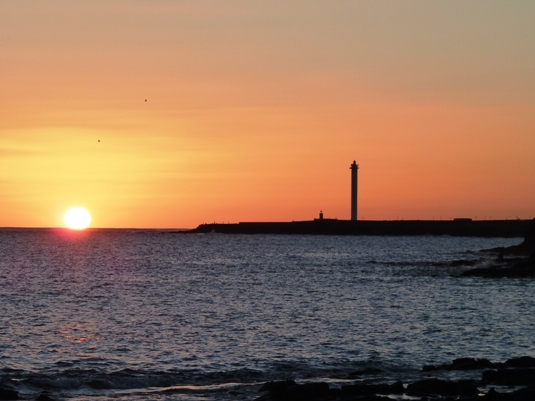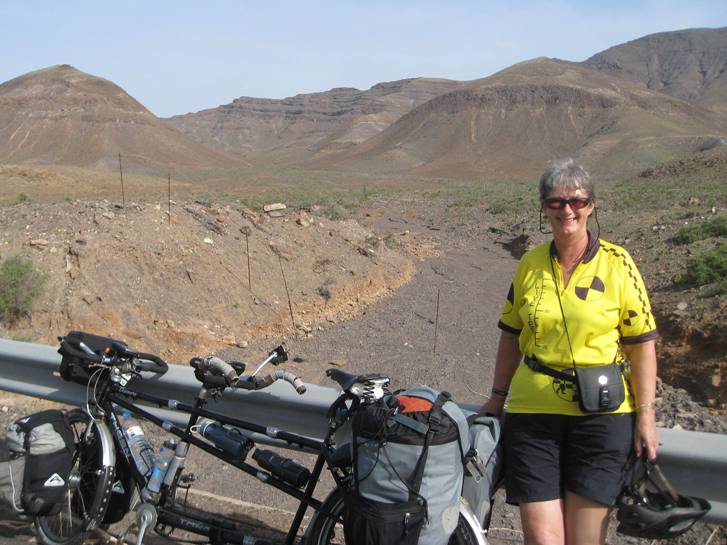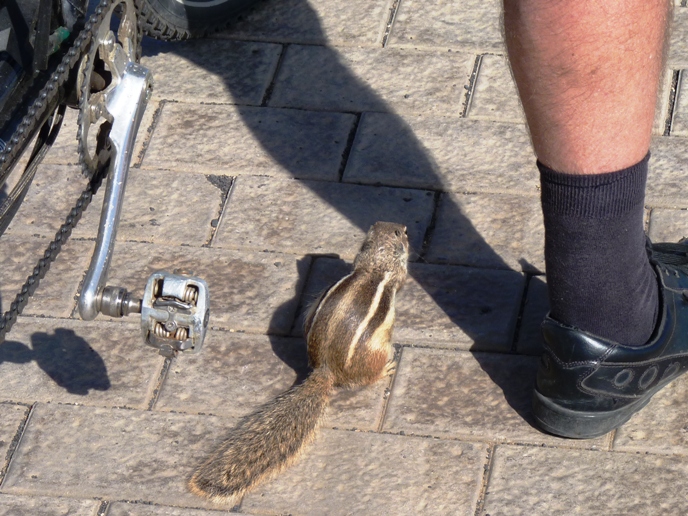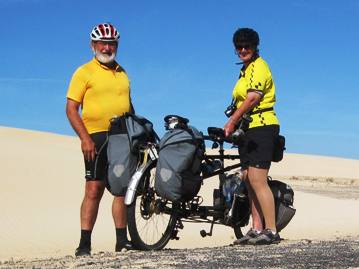4th to 9th January 2011 Tarajalejo, Fuerteventura to Playa Blanca, Lanzarote
We again managed an early start for our longest, but not of course a very long, ride so far. The weather forecast was overcast with a temperature of about 22 degrees. It seemed pretty much ideal weather for a bike ride.
We were of course aware that the ride would start and end at sea level and be entirely on the FV2. We had no idea of the amount of climb or the level of traffic or road conditions. We were pleasantly surprised on both fronts.
The road was almost all single carriageway with a wide hard shoulder for us to ride on. Traffic was not heavy and there were very few large lorries. We certainly had some long climbs but all except one were steady and at an easy gradient.
There was again a change in the countryside and the scenery. After our first climb we came to a wide valley. In earlier times before tourism took over it was an agricultural area. As we climbed out of the valley into a national park we passed through areas of black lava flows. We were then into higher mountain plains before descending gently back to the coast at Caleta.
Once past the busy golfing resort of Caleta we found our apartment hotel on a nearby hill overlooking the sea. As soon as we started to check in we realised that we had crossed the border between Germany and the UK somewhere in the coastal mountains. We were greeted in English by the Bulgarian receptionist and clearly the hotel did not expect to welcome any other nationality.
We had had by far our best bike ride to date on this tour. We had made good speed in ideal conditions. We were even photographed by a roadie cyclist as he overtook us on his lightweight bike. It was a very pleasant day.
|
Sand dunes, north Fuerteventura
|
Our fellow guests at our hotel at Caleta came as something of a shock. They were almost all British. A lot of them were clinically obese, 350 pounders as our Canadian cousin says, and their increase in tummy seemed to have involved a migration from brain to belly.
Perhaps the Brits here are no worse than some of the Germans we have met during the past few days. But we can’t understand the Germans so are not so aware of their levels of intelligence and can ignore their matrimonials. Unfortunately the standard of German hotels has fallen over the years but the food in the German hotels has yet to sink to the appalling levels that the Brits abroad accept.
Caleta is a surprisingly pleasant kind of a place as tourist resorts go. We spent a leisurely morning exploring by tandem. We went along the cycle path beside the sea, going from one side to the other very easily. We came back through the centre and via some rather upmarket streets of private villas. Fortunately there is very little high rise here and the aircraft landing at the nearby airport are not very disruptive.
We passed through streets of tat shops and saw one of those annoying little land trains. The stoker remarked that it is a shame that the tourists never see the real Canaries. We agreed however that few would be prepared the leave the poolside and get on a bike or service bus to find out.
Another early start saw us on our way to Playa Blanca on Lanzarote. We felt like proper cycle tourists and made good speed on the undulating road to the ferry. We may have been slightly delusional. We were doing a good average speed but in reality the road was flat and we had a following wind.
The ride around the airport and through Puerto del Rosario was a lot less daunting than it looked on the map or on Google Earth. Around the airport and into Puerto del Rosario huge sums had been spent on road building which if it ever was required is not needed now.
We found that for most of the way we had a wide hard shoulder to ride on. Traffic was light with few large lorries. This type of cycling would be popular with North Americans who would enjoy the lack of traffic by their standards.
Having negotiated the inevitable and totally unnecessary flyover at the airport entrance we crossed the capital of the island quickly and without incident. Like almost all of the urbanisations we have seen here most building work has stopped and there are a very large number of empty construction sites.
Once out of town we were into the desert with its wide vistas and eroded volcanic mountains. It is a hard hot environment which we passed through quickly. We soon emerged into the Parque Natural El Jable and the Dunas de Corralejo.
The white sand dunes are impressive rolling up from the blue sea, across the road and inland. As we neared Corralejo there were large numbers of tourists. Some were exploring the dunes and some just seeking to improve their skin cancers.
The sky to our right was heavily populated with kites belonging to invisible surfers. Cars sported the usual windsurfers and surf boards on their roofs and the usual tacky stickers on their windscreens.
 |
Playa Blanca Lanzarote, sunset |
We caught the ARMAS ferry in Corralejo for Playa Blanca, Lanzarote. Corralejo is a great place for sea, sun, sand and watersports. The sand gets everywhere and unless one likes it in one’s sandwiches and other intimate places it is a place to avoid. The sand also ruins your bike.
Playa Blanca on the other hand is about as civilised as it gets by the sea on these islands. The ferry crossing takes about half an hour and costs far more than it should even for the locals who get a reduced fare.
We had booked a “bungalow” about 1km out of the town centre. All of the town is low rise and many of the buildings owe something to traditional Canaries structures. Many have the iconic chimneys and the pleasing facades seldom found in a modern Spanish town.
The downside is that the only way to accommodate the low rise is for the town to straggle along the coast as it does for about 8km. We actually found that our “bungalow” really was a bungalow, albeit semi-detached from the one next door. It was on a complex entered via reception with the bungalows laid out in a green garden of palms and tropical plants and reached by footpaths.
Our complex had all the usual amenities of a hotel including a large pool area. It stretches from the coast road to the sea with its own access to the promenade and is a very short distance to good beaches for those who, unlike the management, do not want to swim from the rocks.
We spent a very pleasant three days lazing around in the sun and exploring the coast. We were able to cycle along the 8km of promenade. It was noticeable that the Brits were the least aware of the other users of the prom. Most other Europeans expect to share the space as we do. Mind you just like in the UK the vast majority of people over 50 cannot hear our loud bicycle bells.
Overlooking the resort is the Montana Roja, an extinct volcano. Sunday was only 20 degrees so we climbed the 200 metres up to the caldera and walked around its edge. We enjoyed the impressive views of the south of the island and into the caldera.
Playa Blanca is the best beach resort we have come across so far.



